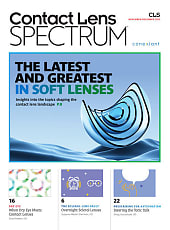Fundamentals of Premium Lenses
Premium optical lenses are unique in several significant ways. Upgrading a client to premium lenses resides in the ability to explain the differences and merits that connect to the wearer’s experience through the lens of a superior product.

Optical lenses fall into two categories: stock/premade and surfaced. Regular or stock lenses are manufactured in bulk, prefabricated with common prescriptions, and stored in standard lens blank sizes for immediate use. The prescription is surfaced into the center of the lens, with a fixed center or edge thickness—generally thicker, especially noticeable in stronger prescriptions. Stock lenses have a higher likelihood of minor distortions and less optimized visual acuity, especially with higher powers or astigmatic corrections.
Surfaced, or custom-made, lenses are individually manufactured from scratch, tailored precisely by taking into consideration the patient’s prescription, frame measurements, pupil position (PD), ocular center (OC) height, vertex distance, pantoscopic tilt, and facial anatomy. Surfaced lenses can be made to any prescription requirements in single-vision, bifocals, progressives, or specialized lenses, making them ideal for complex or high prescriptions, astigmatism corrections, and prism requirements. Surfaced lenses are the premium lens option offering superior optical clarity and precise visual acuity due to precise surfacing techniques that minimize peripheral distortion, improve comfort, and enhance visual performance even in low-prescription requirements.
Free-form surfaced lenses are available in single-vision, multifocal, and occupational lens designs and are the premium benchmark of lenses. Free-form or digital lens surfacing is an advanced technology that uses computer algorithms and precise diamond-tip tools to digitally carve prescriptions onto the back surface of lenses (in some cases, front and back surfaces). With additional customization available, ECPs can utilize digital measuring tools that add patient-specific data points during the manufacturing process, accounting for face form, facial anatomy, head tilt, eye tracking, and the wearer’s individual behavior. Without using traditional lens molds, this method customizes superior-quality lenses to exact visual needs, with increased accuracy up to 1/100 of a diopter—significantly more precise than conventional lenses.
Read on for the key distinctions between regular and premium lenses.
Optical Clarity, Visual Comfort, and Performance
→ Premium lenses: Engineered for superior optical clarity, sharpness, and visual comfort, these lenses provide wider fields of view, smoother transitions, reduced peripheral distortion, and decreased eye fatigue—customized precisely to the wearer’s prescription, frame fit, and positioning.
→ Regular lenses: Standard manufacturing processes result in more visual distortions, particularly in stronger prescriptions and multifocal lens layouts. Less visual sharpness, more swim effect or peripheral distortion, and a smaller optical center create a lower adaptation rate, especially in multifocal layouts.
Aesthetics, Thickness, Weight, and Overall Appearance
→ Premium lenses: Surfaced specifically to be as thin and light as possible based on the customized wearer, frame measurements, and required Rx. By optimizing the optical center placement, lenses can be made to best match the frame shape, resulting in lenses that offer a more pleasing aesthetic appearance.
→ Regular lenses: Need to be placed to match the optical center of the wearer and have a set of limitations based on lens blank size that is not refined for aesthetics, and the results can be thicker, heavier, and less attractive lenses.
Customization and Precision
→ Premium lenses: Take into account additional measurements catering to the individual wearer’s frame choice and Rx needs. Vertex compensation, vertical and horizontal heights, wrap angle, pantoscopic tilt, and base curve can all be specified as part of the lens manufacturing process, creating a custom lens.
→ Regular lenses: Usually standard, stock lenses with limited customization options and potentially less optimal performance. Usuallym only simpler PD and height measurements are taken into account.
Coatings and Treatments
→ Premium lenses: Come with advanced coatings, including a diverse offering of front and back multilayer protection from glare, scratches and wear, water and environmental elements, UV rays, and blue light and artificial lights.
→ Regular lenses: Often equipped with basic or minimal coatings. Although they can still offer some of the above features, they do not typically address all in one premium coating.
Durability, Longevity, and Peace of Mind With Extended Warranties
→ Premium lenses: Offer greater durability, superior scratch resistance, and longer life span, maintaining optical quality longer. Premium, custom-made lenses offer peace-of-mind warranties for ECP changes and non-adapts and typically offer longer coating and lens material warranties (commonly two years against wear and tear and manufacturer defects).
→ Regular lenses: Can have a shorter life span due to susceptibility to scratches, coating degradation, and decreased clarity over time. They may offer no—or only a short—lens warranty for defects or wear and tear. Regular lenses are often less expensive and are viewed as more disposable and less long-term-oriented than premium lenses.
Understanding the distinctions between regular and premium optical lenses is essential in guiding your clients toward a superior visual experience. Premium lenses offer precise optical clarity and tailored customization. Explaining these differentiating factors allows the ECP to position premium lenses not merely as an option but also as an optimal solution for enhanced vision, comfort, and long-term satisfaction.
—Sheena Taff



